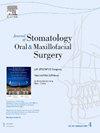Application of absorbable internal fixation system in secondary rhinoplasty of patients with unilateral cleft lip
IF 2
3区 医学
Q2 DENTISTRY, ORAL SURGERY & MEDICINE
Journal of Stomatology Oral and Maxillofacial Surgery
Pub Date : 2025-10-01
DOI:10.1016/j.jormas.2025.102493
引用次数: 0
Abstract
Background
Postoperative nasal asymmetry is a common secondary deformity following correction of unilateral cleft lip, with insufficient structural reinforcement along the nasal midline representing a key etiological factor.
Purpose
To address the clinical challenge of nasal asymmetry in unilateral cleft lip patients caused by insufficient midline nasal support, this study proposes the use of an absorbable internal fixation system for nasal scaffold reconstruction and evaluates its therapeutic efficacy.
Methods
This retrospective study included patients with unilateral cleft lip nose. An absorbable internal fixation system was used in combination with the nasal septal cartilage to reconstruct the nasal cartilage framework. The participants were assessed preoperatively (T0), 1 week postoperatively (T1), and 6 months postoperatively (T2). The four measurements evaluated in this study were the nasal deviation angle (∠α), nasal height ratio (NH/NH'), nasal prominence angle (∠Al–Ns–Prn), and nasolabial angle (∠Cm–Sn–UL). One-way analysis of variance was used for the statistical analyses of the measurement results.
Results
The sample was composed of 21 consecutive patients with a mean age of 19.04 ± 4.72, 11 (52.38 %) were male and 13 (61.9 %) had right cleft lip nose. No complications were observed during the follow-up period. The ∠α decreased significantly from T0 to T1 (P < 0.05), whereas the NH/NH' (P < 0.001), ∠Cm–Sn–UL (P < 0.001), and ∠Al–Ns–Prn (P < 0.01) increased significantly from T0 to T1. No statistical differences were observed between T2 and T1 in any measurements, except in the ∠Cm–Sn–UL (P < 0.001).
Conclusion
The novel method proposed in this study effectively corrected the unilateral cleft lip nose and maintained stability during the follow-up period.
可吸收内固定系统在单侧唇裂患者二次鼻整形中的应用。
背景:术后鼻不对称是单侧唇裂矫治后常见的继发畸形,沿鼻中线结构加固不足是一个关键的病因。目的:针对单侧唇裂患者因鼻中线支撑不足导致鼻部不对称的临床挑战,本研究提出采用可吸收内固定系统进行鼻支架重建,并评价其治疗效果。方法:对单侧唇裂鼻患者进行回顾性研究。采用可吸收内固定系统联合鼻中隔软骨重建鼻软骨框架。术前(T0)、术后1周(T1)和术后6个月(T2)对参与者进行评估。测量鼻偏角(∠α)、鼻高比(NH/NH’)、鼻突出角(∠Al-Ns-Prn)、鼻唇角(∠Cm-Sn-UL)。测量结果采用单因素方差分析进行统计分析。结果:本组患者共21例,平均年龄19.04±4.72岁,男性11例(52.38%),右唇裂鼻13例(61.9%)。随访期间无并发症发生。从T0到T1,∠α值显著降低(P < 0.05),而NH/NH′值(P < 0.001)、∠Cm-Sn-UL值(P < 0.001)、∠Al-Ns-Prn值(P < 0.01)显著升高。T2与T1间除∠Cm-Sn-UL外,其他指标均无统计学差异(P < 0.001)。结论:本研究提出的新方法有效地矫正了单侧唇裂鼻,并在随访期间保持了稳定性。
本文章由计算机程序翻译,如有差异,请以英文原文为准。
求助全文
约1分钟内获得全文
求助全文
来源期刊

Journal of Stomatology Oral and Maxillofacial Surgery
Surgery, Dentistry, Oral Surgery and Medicine, Otorhinolaryngology and Facial Plastic Surgery
CiteScore
2.30
自引率
9.10%
发文量
0
审稿时长
23 days
 求助内容:
求助内容: 应助结果提醒方式:
应助结果提醒方式:


